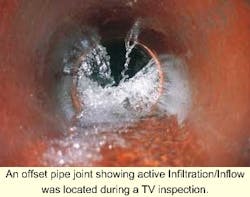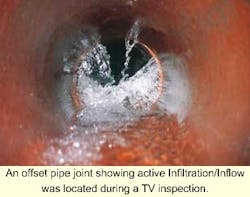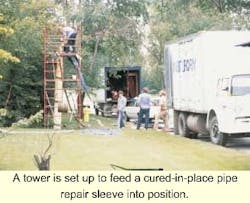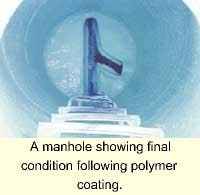Pipe Repair Systems-Choosing The Right Rehabilitation Method
The job of a municipal sanitary sewer system manager is difficult these days. With limited funding, increasingly stringent compliance requirements, aging infrastructure and sanitary sewer overflows (SSO), managers are faced with the daunting task of keeping their systems in good working order. Looming on the horizon is Governmental Accounting Standards Board (GASB) Statement 34, going into effect June 15, 2001, which requires all current and long-term assets and liabilities to be reported on the balance sheets of governmental financial statements. Those assets include sanitary sewer systems, many of which have not received adequate preventative maintenance in decades.
Given the reality of insufficient funds to replace large portions of a municipal sanitary sewer system, most managers are investigating techniques for extending the life of their collection system assets through pipe and manhole rehabilitation.
The investment underground in sewer collection system lines is enormous. Even a relatively small community of 50,000 will have an estimated 1,150,000 linear feet (217 miles) of gravity sewer lines. With replacement commonly costing $100 per linear foot, total system replacement would cost $115 million. Locating all pipes and manholes in need of repair, then developing a priority listing of those needs, is the key to successfully managing a rehabilitation program.
Various evaluation methods can be used including flow monitoring, manhole inspection, smoke testing and internal TV inspection. Each method has its purpose and can be used in combination to develop a comprehensive rehabilitation plan. Regardless of the methods used, accurate reliable information regarding existing pipe and manhole conditions is critical to ensure that the appropriate rehabilitation method is selected.
Setting Priorities
In a comprehensive rehabilitation program key data include information gathered during the evaluation process, along with historical emergency repair records and customer complaints. The collection system manager uses these data to beginto identify those system defects that should be targeted. An objective priority ranking system is helpful at this stage of the program. Historically, a "cost effectiveness analysis," as outlined by EPA during the 201 Facilities Grants Program, has been used to determine priorities. However, conventional cost effectiveness analysis does not address future deterioration, structural defects or capacity issues, and focuses only on those defects that eliminate large amounts of Infiltration/Inflow (I/I). As a result, many types of defects are not "cost effective" to repair and therefore are not appropriately evaluated.
A more practical approach to developing a priority ranking system is based on defect severity, i.e., whether a defect poses a public safety risk, whether it causes a reduction of system performance or whether it contributes to I/I or sanitary sewer overflows. Additionally, the number of defects on a given line segment, capacity issues and future capital improvement needs can be assessed. Other considerations can be included depending upon specific goals of the municipality. Each criterion can be objectively evaluated by assigning a ranking number, for instance from number 1 to 3, with certain criteria weighted based upon program objectives. Database software commonly available on the market can be used to organize the data and calculate an overall priority ranking for each defect.
Once an overall priority ranking has been developed, the type of rehabilitation method can be selected. The method to be used will be dependent upon many factors, not the least of which is what type of defect is to be repaired.
Questions to Answer Before Getting Started
When approaching rehabilitation of pipes or manholes the first thing to be determined is what is the purpose of the rehabilitation. Is the goal to eliminate Infiltration/Inflow, make a structural repair, improve system capacity or a combination? The answers to these questions will dictate the type of rehabilitation method used.
Chemical Grouting
One commonly used method of non-structural repair is chemical grouting. Ideally suited to stopping leakage and reducing soil loss, grouting consists of injecting a self-setting grout into structurally sound leaking joints or small wall cracks. The grout travels outside of the joint or manhole wall, into surrounding soils and bonds with those soils to create a seal collar of material around the leaking joint or wall defect.
Grouting effectively can be performed on pipes 6 inch and larger in diameter, as long as protruding taps or significantly dropped joints do not impede the passage of the grout packer. Surrounding soils must be of a type that the grout can bond with them. Clay and glacial tilth usually are not suitable soils while sand and gravel are ideal. Pipes with significant soil voids behind leaking joints or those with pipe under-drains may be better suited to other rehabilitation techniques. Acrylamide and Urethane grouts are the most common on the market, with various additives available to increase/decrease setting times and increase strength, flexibility and durability.
Internal Pipe Seals
Internal mechanical seals are well suited to applications where vibration or shifting of the pipe can be anticipated. Typically made of impervious, flexible rubber gaskets and stainless steel bands, internal pipe seals are installed at leaking pipe joints or as a preventative measure. In cases of harsh environment, several bands can be linked together to act as sheathing of the pipe. Banding material can be custom manufactured to suit environmental conditions. Odd shaped pipes including egg and square can be accommodated. New, low profile designs reduce historical problems concerning loss of flow area and build-up of debris.
Due to the nature of their installation, internal pipe seals require manned entry into pipes and therefore are available only for pipes 16 inch and larger. No excavation is required but by-pass pumping may be necessary.
Sliplining
Sliplining is a method by which a pipe is inserted into an existing line by either pulling or pushing continuous or short-length pipes, frequently HDPE pipe. It is a relatively cost efficient method where existing capacity is sufficient, as a significant amount of internal area is lost during the slip lining process. The pipe is inserted in a variety of methods, depending upon both the length of pipe and its material. With traditional sliplining, a lead-in trench must be excavated for installation. Pipes are butt-welded on the surface of the ground before being winched or jacked into the existing pipe. Additional pipe lengths are added as needed. For short sections of pipe, the pipes can be joined together by special gasketed joints and jacked into place. Both flexible and rigid mechanical gaskets can be used to join the short sections together. Depending upon pipe size and access, an excavation trench may not be required for sliplining using short sections of pipe.
Grouting the annular space between the lining and the original pipe is recommended, both to stop infiltration from migrating down the annular space between the pipes and to provide additional strength. Significantly dropped joints, roots and other impediments to the insertion of the pipe must be repaired or removed prior to installation. Laterals must be reconnected by excavation. Bypass pumping is required during installation for conventional sliplining methods but may not be necessary for segmental sliplining.
While relatively cost efficient in most instances, the installation can be disruptive due to the excavation required for the installation trench and lateral re-connection. Especially deep installation may make the method less desirable due to increased costs. In some instances, lack of access may make traditional slip lining impractical.
Cured-in-Place Pipe (CIPP)
Considered a trenchless repair, CIPP liners use a polyester flexible sock or sleeve impregnated with resin that is inverted or winched into the pipe. The sock is inverted using either winch inversion, water inversion or air (steam) inversion. Inversion allows the liner to conform to the existing pipe contours providing for minor irregularities or slight changes of pipe direction. The thickness of the pipe can be increased by increasing the thickness of the polyester sock.
Both ambient cure and thermal cure products are available. Ambient cure relies on a chemical reaction to harden the resin and may be better suited to short sections of pipe due to its quick cure time and relatively simple installation setup. A four to eight foot section of 12'' ambient cure CIPP may cure in as little as two to four hours. However, this quick cure time may make the method inconvenient for longer stretches of pipe. Thermal cure CIPP uses hot water or steam to activate the hardening of the resins in the sock, so setting time is dictated by the installer. However, curing times are longer. Bypass pumping usually is required for either method.
Because the lining is designed to fit closely to the existing pipe, grouting of the annular space usually is not required. Both methods require no, or very limited, excavation; and lateral connections can be reconnected internally, making the process ideally suited for crowded urban environments or locations with restricted access. The sealing or lining of laterals using internal robotics often is required to curtail leak migration in lines where I/I reduction is one of the rehabilitation objectives.
Fold and Formed Pipe
Another trenchless repair, the fold-and-formed method uses deformation to reduce the pipe diameter of conventionally formed pipe. Deformation of the pipe can be done either during fabrication or on site, depending on the product. The pipe is either rolled down from a continuous roll or fusion welded together before installation. In bothcases, the new pipe then is pulled into the existing pipe in the manner of traditional sliplining. Once winched into place, the pipe is expanded back into its original shape, forming a close fit with the existing pipe. The process of the pipe expansion may be accelerated by air pressure and heat. As with CIPP, because the close fit of the new pipe to the old, grouting of the annular space usually is not required. Laterals may be reconnected internally or by excavation. As with CIPP, laterals may require sealing or lining in order to eliminate migration of I/I. By-pass pumping usually is required.
Pipe Bursting
Pipe bursting works by using a pneumatic or hydraulic bursting mandrel to crush the existing pipeline while at the same time a new pipe can be pulled into place. The crushed pipe is forced into surrounding soils, acting as bedding material for the new pipe. A sleeve pipe is pulled immediately behind the bursting mandrel during the process. Following completion, the sleeve pipe is lined with a new pipe, typically HDPE. Pipe bursting is well suited to brittle pipes and allows for the size-for-size or increased size replacement of the existing pipe.
Pipe bursting typically can be performed on distances as great as 300 feet or more, depending on surrounding soils and ground conditions. Offset joints and short or minor line swags can be eliminated during the process. Excavation of an insertion trench is required, usually at a manhole, and laterals must be reconnected by excavation. Some ground upheaval may occur where pipes are close to the ground service or where surrounding soils are not easily compressed. Bypass pumping is required during the process.
Coatings
Frequently used for manhole rehabilitation, coatings have evolved over the years into specialized compounds designed for a variety of environmental and site conditions. Broad categories include cementitious and polymer coatings. Both types either are sprayed or hand applied to cleaned and prepped manhole interiors. Preparation is critical to the success of application, with a clean, sound substrate necessary for either type. Before application, high pressure washing, usually from 3500 psi to 5000 psi, is necessary to adequately etch brick, remove loose materials, grease or other foreign matter from the manhole walls, bench and invert.
All active groundwater infiltration must be eliminated by using chemical grouts, high early strength repair mortars, resin impregnated materials or other appropriate water stopping compounds. During preparation, manhole benches and inverts should be repaired or rebuilt as necessary.
Coatings can be used to cover the entire manhole including bench and inverts. In each application, the coating material is applied in one or more layers depending upon desired final thickness. The profile of the substrate dictates the minimum thickness required for pin-hole, or "holiday" free application. The industry standard for holiday free application of material is 1/2 inch for cementitious and 65 mm for polymer coatings. A 2:1 safety factor often is employed resulting in a typical minimum application of 1 inch for cementitious and 100 mm for polymers on structurally sound existing manholes or new construction. Structural integrity can be improved with applications of two inch to four inch for cementitious and up to 125 mm for polymers on rehabilitation.
Cementitious coatings are typically the most cost effective and with sufficient reinforcing and thickness can provide structural integrity. However, they provide limited corrosion resistance unless additives are included in the mix. Polymers provide excellent corrosion resistance, but are more expensive. Used in combination, a balance can be reached between economy and functionality.
In either case, care should be taken during the application and inspection process to ensure holiday-free application. Vacuum testing and/or pull tests should be performed to assess the success of the application. Pull tests of 300 psi should be a standard for either process.
Meeting the Challenge
The above discussion of rehabilitation methods is by no means a comprehensive listing. Traditional open-cut, point repairs and a multitude of exotic methods all have their place in the arsenal of collection system managers as they strive to meet the challenges of maintaining today's aging infrastructure.
As collection systems continue to deteriorate and funding remains limited, new, economical methods will continue to be developed. Setting priorities, accurately evaluating existing conditions and proper selection of the appropriate technique still will be the keys to a successful rehabilitation program.
About the Authors: Norman A. Sirna has more than 40 years of experience in the sewer inspection and rehabilitation industry, beginning as an employee of the Metropolitan St. Louis Sewer District in 1956. A Senior Rehabilitation Principal for Severn Trent Pipeline Services, Sirna is an active member of the National Association of Sewer Service Companies (NASSCO), and was President of the organization in 1991 and 1992. Tracy Favre, P.E., has 14 years experience in turn-key collection system evaluations for municipal and industrial clients. She is currently the Director of Marketing for Severn Trent Pipeline Services.



